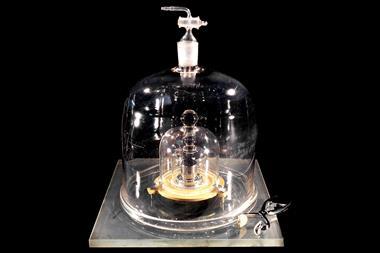Most precise value yet reduces uncertainty down to 20 atoms in a billion
![]()
A new milestone has been passed on the way to redefining the kilogram in terms of Planck’s constant by 2018. Research teams from Italy, Japan and Germany have correlated two of the most precise measurements of Avogadro’s number to obtain one average value whose relative uncertainty is less than 2 x 10-8, equivalent to 20 atoms per billion, the agreed threshold of uncertainty.
In 2011, the International Bureau of Weights and Measures agreed that the kilogram should be redefined in terms of Planck’s constant. This in turn requires an international consensus on the value of Planck’s constant. Two approaches have been adopted to obtain this value, one is to use an electronic device called a Watt balance, the other is to derive the constant from Avogadro’s number, obtained by counting the number of silicon atoms in two 1kg silicon spheres.
Multiple labs across the world are working on both approaches, gradually refining results and reducing uncertainties. One measurement of Avogadro’s number in 2011 produced a result with a relative uncertainty of 3 x 10-8, while a second measurement in 2015 reduced this to 2 x 10-8. Now, a team led by metrologists from Italy’s national institute for metrological research (INRIM) has carried out detailed statistical analyses of the two sets of measurements to arrive at an ‘averaged’ result. ‘Provided that we estimate their correlation – that is, how big or small is the chance that we made the same error in both measurements – we can “average” them, by taking the correlation value into account when averaging, to extract a “neutral” and a bit more accurate value,’ says INRIM team member Carlo Sasso. This yielded a value for Avogadro’s number of 6.02214082(11) x 1023 (the number in parentheses represents the uncertainty of the last digit in the result), with a relative uncertainty of 1.8 x 10-8.
Ian Robinson, of the National Physical Laboratory in the UK, who works on the Watt balance side of the international effort, is encouraged by the progress that is being made. ‘I think we are in a pretty good shape and hopefully we will get into even better shape,’ he says. ‘The most recent Watt balance results have an uncertainty of around 1.9 x 10-8. One of the beauties of these two approaches – the Avogadro and the Watt balance – is that while they are totally different experiments they are in really in tight agreement and that is very hopeful.’











No comments yet